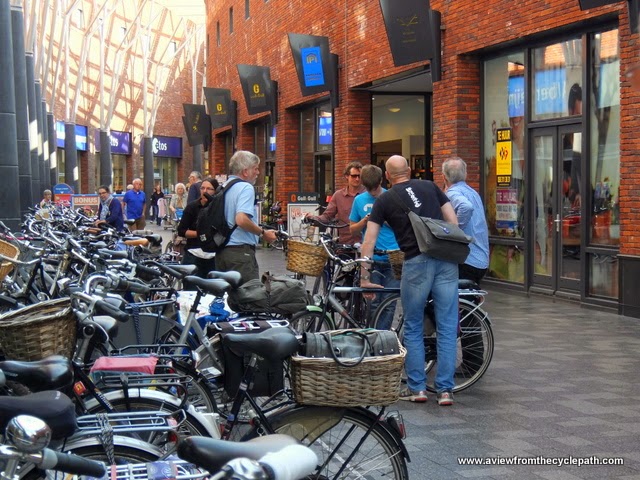I understood that the Netherlands made it's strategic decisions on bikes instead of cars way earlier than this so perhaps someone has alternate stories to tell.
Anyhow, have a look at "How Amsterdam became the bicycle capital of the world" http://www.theguardian.com/cities/2015/ ... ign=buffer
How Amsterdam became the bicycle capital of the world
- ColinOldnCranky
- Posts: 6734
- Joined: Fri Feb 27, 2009 4:58 pm
How Amsterdam became the bicycle capital of the world
Postby ColinOldnCranky » Wed May 06, 2015 4:31 pm
Unchain yourself-Ride a unicycle
-
human909
- Posts: 9810
- Joined: Tue Dec 01, 2009 11:48 am
Re: How Amsterdam became the bicycle capital of the world
Postby human909 » Wed May 06, 2015 5:56 pm
That's the story as I have understood it. Bicycles in use all over Europe and Australia before and after WWII. Before WWII for average joe it was either walking or cycling or public transport (in big cities). Also during the war the Dutch didn't have cars to transport them, so they had to rely on bikes. To help move all its people, sydney had one of the biggest tram networks in the world. It was only the 50s that saw widespread adoption of private motor vehicles.
In the same way the Dutch chose bicycle we chose cars. We ripped up a very good tram network in Sydney.



How many more people can be moved by trams as opposed to cars?
In the same way the Dutch chose bicycle we chose cars. We ripped up a very good tram network in Sydney.



How many more people can be moved by trams as opposed to cars?
- il padrone
- Posts: 22931
- Joined: Mon Apr 07, 2008 11:57 pm
- Location: Heading for home.
Re: How Amsterdam became the bicycle capital of the world
Postby il padrone » Wed May 06, 2015 6:05 pm
As you can clearly see from the graph of bicycle share of transport on the first part of that page, the Netherlands had very high bicycle use back in the 20s to 50s - some cities over 80%. Many other cities in this time did rely more heavily on bike use and PT (even in Australia). But during the 60s even in the Netherlands, along with most of the western world, cars came to dominate. The Netherlands went on freeway programs and began to give their medieval town squares over to car parking, and bicycle use fell to a low of about 15-20%. The early 70s saw a compaign (Stop de Kindermoord) against the dangers of motor vehicle traffic, together with the Oil Crisis of 73 that resulted in a sharp change in governement policies, to encourage cycling and reduce car-dependence. This is the 'fightback' and it is still underway with bicycle use creeping back over 40% in some cities.
On the same graph Manchester (UK) parallels this, but without any moves back towards higher bike use. Conscious government policies do make a great difference.

On the same graph Manchester (UK) parallels this, but without any moves back towards higher bike use. Conscious government policies do make a great difference.

David Hembrow wrote:1974: At one time, Assen couldn't provide enough car parking. This is how the main city square was used.[/quote
Same city square in use today
Other changes have been applied to make cycling much more convenient for everyone:
 David Hembrow wrote:This shopping centre has cycle-paths at one end and other well designed infrastructure at the other end providing safe routes to both doors. Bicycles can be taken inside and parked right next to the shops. Car parking is free of charge for shoppers but cycling is the most popular way of visiting the supermarket.
David Hembrow wrote:This shopping centre has cycle-paths at one end and other well designed infrastructure at the other end providing safe routes to both doors. Bicycles can be taken inside and parked right next to the shops. Car parking is free of charge for shoppers but cycling is the most popular way of visiting the supermarket.
Mandatory helmet law?
"An unjustified and unethical imposition on a healthy activity."
"An unjustified and unethical imposition on a healthy activity."
Return to “Cycling Safety and Advocacy”
Jump to
- General Australian Cycling Topics
- Info / announcements
- Buying a bike / parts
- General Cycling Discussion
- The Bike Shed
- Cycling Health
- Cycling Safety and Advocacy
- Women's Cycling
- Bike & Gear Reviews
- Cycling Trade
- Stolen Bikes
- Bicycle FAQs
- The Market Place
- Member to Member Bike and Gear Sales
- Want to Buy, Group Buy, Swap
- My Bikes or Gear Elsewhere
- Serious Biking
- Audax / Randonneuring
- Retro biking
- Commuting
- MTB
- Recumbents
- Fixed Gear/ Single Speed
- Track
- Electric Bicycles
- Cyclocross and Gravel Grinding
- Dragsters / Lowriders / Cruisers
- Children's Bikes
- Cargo Bikes and Utility Cycling
- Road Racing
- Road Biking
- Training
- Time Trial
- Triathlon
- International and National Tours and Events
- Cycle Touring
- Touring Australia
- Touring Overseas
- Touring Bikes and Equipment
- Australia
- Western Australia
- New South Wales
- Queensland
- South Australia
- Victoria
- ACT
- Tasmania
- Northern Territory
- Country & Regional
Who is online
Users browsing this forum: No registered users
- All times are UTC+10:00
- Top
- Delete cookies
About the Australian Cycling Forums
The Australian Cycling Forums is a welcoming community where you can ask questions and talk about the type of bikes and cycling topics you like.
Bicycles Network Australia
Forum Information
Connect with BNA
Brought to you by Bicycles Network Australia | © 1999 - 2024 | Powered by phpBB ®
This website uses affiliate links to retail platforms including ebay, amazon, proviz and ribble.
This website uses affiliate links to retail platforms including ebay, amazon, proviz and ribble.
